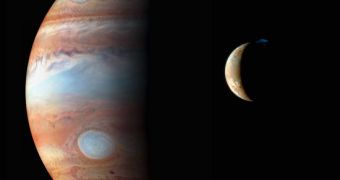While discussions over climate change are raging on back on Earth, it may be that we are not the only planet in the solar system to experience this phenomenon. According to new readings from the Hubble and Keck telescopes, Jupiter may currently be in the midst of a very violent period of global warming, as evidenced by its massive, red storms. University of California in Berkeley (UCB) professor of mechanical engineering Phil Marcus first proposed the idea in 2004, Daily Galaxy reveals.
The latest readings seem to indicate that the gas giant's equator is getting warmer, whereas the South Pole is getting cooler. Measurements reveal that the temperature may be varying by as much as 15 to 20 degrees Fahrenheit, which is a lot. On Earth, a warming trend of 2 degrees Celsius would melt sufficient ices to redraw the world map. Behind Jupiter's “signature” banded look are twelve jet streams, which apparently become unstable and spawn new vortices.
This in turn leads directly to the creation of more storms, the expert says. In fact, the famous Red Spot on the surface of the gas giant, wrongfully labeled a storm for many years, is calmer than many other regions of the planet's atmosphere. This fact is obvious to astronomers who spend their time analyzing minute variations in Jupiter's atmospheric properties. Around the Great Red Spot, wind speed can reach as much as 200 miles per hour, as opposed to the wind speed inside, which rarely goes over 9 miles per hour.
In visible-light images taken May 9-10 with Hubble's Wide Field and Planetary Camera 2, a third Red Spot was identified on the gas giant, to the west of its larger cousin. The new feature originally developed as a white oval-shaped storm, but then turned red, which means that its clouds have begun climbing in altitude, until they reached the same height as the clouds in the Great Red Spot. The brick red color we are so accustomed to is produced when solar ultraviolet radiation hits the atmospheric front. However, the reactions that are the basis for this phenomenon are unknown at this point.
The latest pictures of the planet reveal that, more than two years after they first appeared, the new atmospheric formations continue to develop above the surface of Jupiter. Most likely, the formation will continue to exist in parallel for many years. The first astronomical observations of the planet show that the Great Red Spot is at least 200 to 350 years old.

 14 DAY TRIAL //
14 DAY TRIAL //